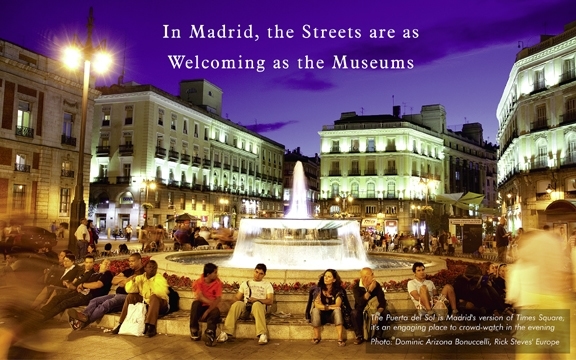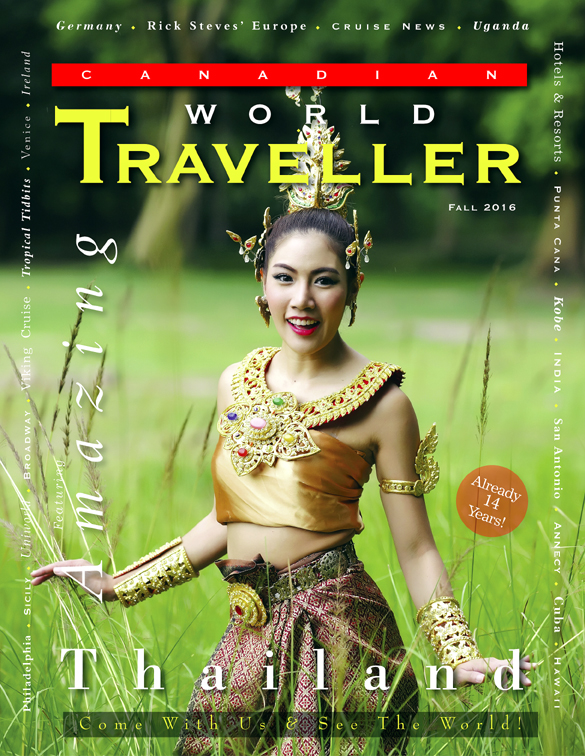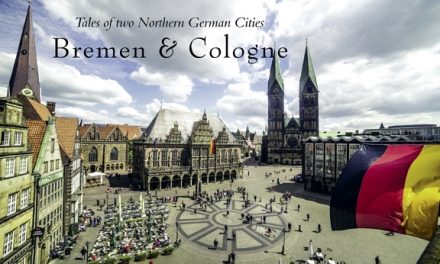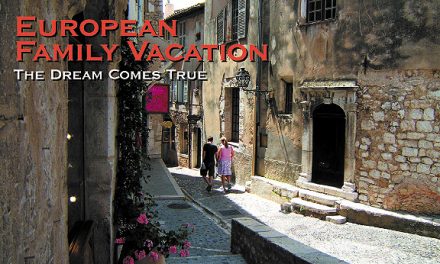Spain
In Madrid, the Streets are as Welcoming as the Museums
by Rick Steves
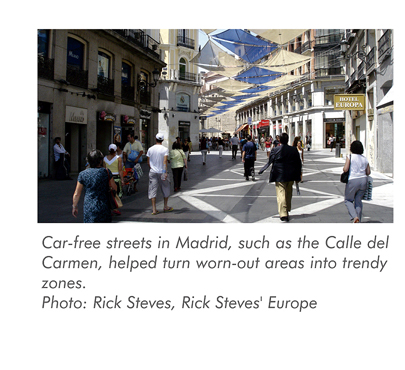
Once known mainly for its museums and palaces, Madrid’s cityscape is changing. Madrid is working hard to make itself more livable, and the lively city of today has enough street-singing, bar-hopping, and people-watching vitality to give any visitor a boost of youth.
Massive urban-improvement projects such as pedestrianized streets, parks, commuter lines, and Metro stations are transforming Madrid. The investment is making once-dodgy neighborhoods safe and turning ramshackle zones into trendy ones. The broken concrete and traffic chaos of the not-so-distant past are gone.
Today’s Madrid feels orderly while remaining upbeat and vibrant–get ready to dive headlong into its grandeur and intimate charm. Madrid’s historic center is pedestrian-friendly and filled with spacious squares, a trendy market, bulls’ heads in a bar, and a cookie-dispensing convent.
A wonderful chain of pedestrian streets crosses the city east to west, from the Prado to Plaza Mayor (along Calle de las Huertas) and from Puerta del Sol to the Royal Palace (on Calle del Arenal). Madrileños have a passion for shopping, and most shoppers focus on the colorful area around Gran Vía and Puerta del Sol. Here’s the spot to pick up some mantones (typical Spanish shawls), castañuelas (castanets), and peinetas (hair combs) for the folks back home. The fanciest big-name shops (Gucci, Prada, and the like) tempt strollers along Calle Serrano.
For an interesting Sunday, start at Plaza Mayor, where Europe’s biggest stamp and coin market thrives. Enjoy this genteel delight among old-timers paging lovingly through each other’s albums, looking for win-win trades. Then take a green and breezy escape from the city at Madrid’s main park, Retiro Park, which becomes a carnival of fun on weekends with splendid picnicking, row boating, and people-watching.
Save some energy for after dark, when Madrileños pack the streets for an evening paseo. The paseo is a strong tradition in this culture–people of all generations enjoy being out, together, strolling. Even past midnight on a hot summer night, entire families with little kids are licking ice cream, greeting their neighbors, and enjoying little beers and tapas in a series of bars. Join the fun–anyone is welcome.
The historic center is enjoyably covered on foot. No major sight is more than a 20-minute walk from Madrid’s lively main square, the Puerto del Sol–the pulsing heart of modern Madrid and of Spain itself. It’s a hub for the Metro, commuter trains, revelers, pickpockets, and performers dressed as Spanish cartoon characters. (Spanish parents love to pay for their kids to get a photo with their favorite TV heroes.)
The Puerto del Sol is a prime example of a spot that changed from a traffic nightmare to an inviting people zone. Nearly traffic-free, it’s a popular site for political demonstrations. Don’t be surprised if you come across a large, peaceful protest here. And just as in New York’s Times Square, crowds gather here on New Year’s Eve, cheering as Spain’s “Big Ben” atop the governor’s office chimes 12 times.
From Puerta del Sol, you can easily do a blitz tour of three major sights. Within a 15-minute walk you can visit one of Europe’s greatest palaces (the lavish Royal Palace), the ultimate town square (Plaza Mayor), and my favorite collection of paintings under any single roof in Europe (the Prado Museum).
Start with the Royal Palace, which rivals Versailles with its gilded rooms and frescoed ceilings. It’s big–more than 2,000 rooms, with tons of luxurious tapestries, a king’s ransom of chandeliers, priceless porcelain, and bronze decor covered in gold leaf. While these days the royal family lives in a mansion a few miles away, the palace is still used for formal state receptions, royal weddings, and tourists’ daydreams.
One highlight is the throne room, where red velvet walls, lions, and frescoes of Spanish scenes symbolize the monarchy in a Rococo riot. Another eye-stopper is the dining hall, where the king can entertain as many as 144 guests at a bowling lane–size table. The ceiling fresco depicts Christopher Columbus kneeling before Ferdinand and Isabel, presenting exotic souvenirs and his New World “friends” to the royal couple.
The next stop is Plaza Mayor–a stately, traffic-free chunk of 17th-century Spain. In early modern times, this was Madrid’s main square. It is enclosed by three-story buildings with symmetrical windows, balconies, slate roofs, and steepled towers. Each side of the square is uniform, as if a grand palace were turned inside-out. This distinct “look” pioneered by architect Juan de Herrera is found all over Madrid. Day or night, Plaza Mayor is a colorful place to enjoy an affordable cup of coffee or overpriced food.
An equestrian statue honors Philip III, who transformed an old marketplace here into a Baroque plaza in 1619. Bronze reliefs under the lampposts detail the Spanish history that played out upon this stage. The square once hosted bullfights and was the scene of generations of pre-Lent carnival gaiety. During the Inquisition, many suspected heretics were tried here and punished by being strangled or burned at the stake. Thankfully, those brutal events are long gone.
The last stop on our tour is the Prado Museum, which holds one of my favorite collections of paintings anywhere. With more than 3,000 canvases, including entire rooms of masterpieces by superstar painters, the museum gives an eye-pleasing overview of Spain’s rich history, from its Golden Age through its slow fade.
The Prado is the place to enjoy the great Spanish painter Francisco de Goya. You can follow this complex man through the stages of his life–from dutiful court painter, to political rebel and scandal-maker, to the disillusioned genius of his “black paintings.” It’s also the home of Diego Velázquez’s Las Meninas, considered by some to be the world’s finest painting, period. In addition to Spanish works, you’ll find paintings by Italian and Flemish masters, including Hieronymus Bosch’s fantastical Garden of Earthly Delights altarpiece.
As you walk back to Puerta del Sol, reflect on this bustling capital–home to more than four million people. Despite economic uncertainty, today’s Madrid is energetic. Even the living-statue street performers have a twinkle in their eyes. After every trip to this exciting city, the impression I take home is that of a thriving people with an enduring culture.
© 2016 Rick Steves’ Europe. All rights reserved.
Rick Steves (www.ricksteves.com) writes European travel guidebooks and hosts travel shows on public television and public radio. Email him at rick@ricksteves.com.
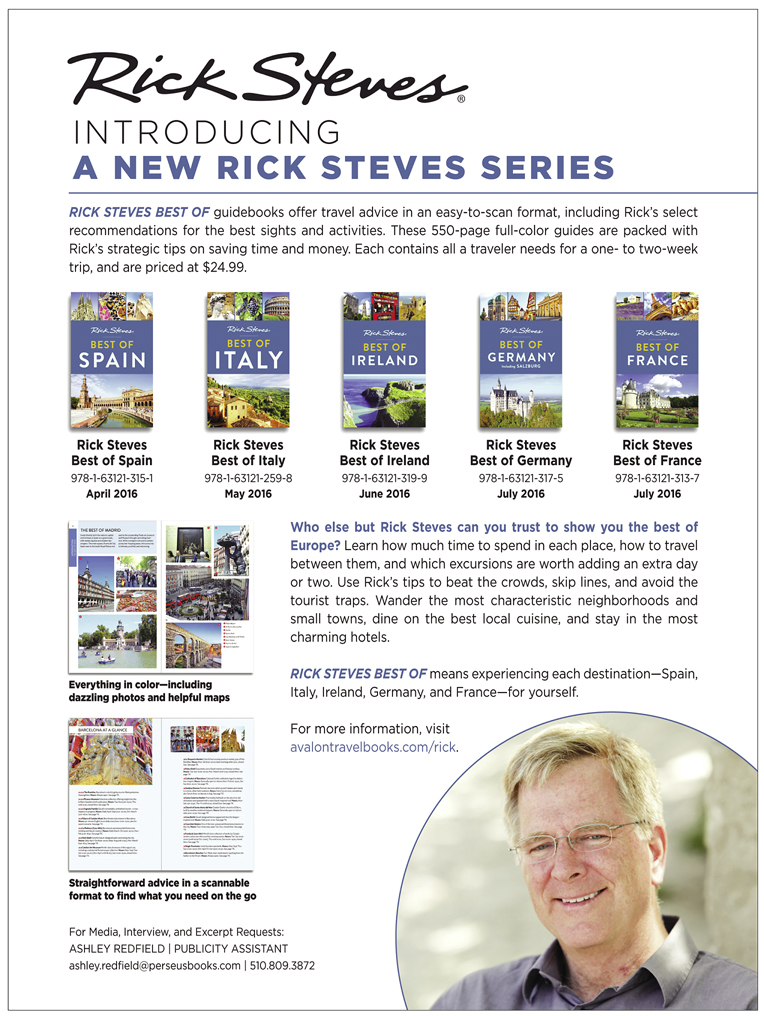
Click on cover to view published article

